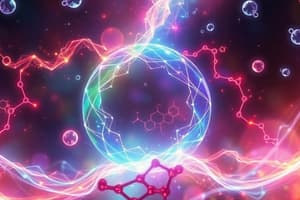Podcast
Questions and Answers
What type of hydrocarbons contain only single bonds?
What type of hydrocarbons contain only single bonds?
- Alkynes
- Alkanes (correct)
- Cycloalkanes
- Alkenes
Which principle states that a system at equilibrium will shift to counteract disturbances?
Which principle states that a system at equilibrium will shift to counteract disturbances?
- Arrhenius Theory
- Dalton's Law
- Le Chatelier's Principle (correct)
- Gibbs Free Energy
What is the study of carbon-containing compounds called?
What is the study of carbon-containing compounds called?
- Organic Chemistry (correct)
- Inorganic Chemistry
- Analytical Chemistry
- Biochemistry
Which technique is used to determine the concentration of a solution?
Which technique is used to determine the concentration of a solution?
Which of the following describes an unsaturated hydrocarbon with at least one double bond?
Which of the following describes an unsaturated hydrocarbon with at least one double bond?
What type of bond is characterized by the transfer of electrons?
What type of bond is characterized by the transfer of electrons?
Which state of matter has a definite shape and volume?
Which state of matter has a definite shape and volume?
In a chemical equation, what are the substances called that undergo change?
In a chemical equation, what are the substances called that undergo change?
What occurs during a decomposition reaction?
What occurs during a decomposition reaction?
What is the pH range of a neutral substance?
What is the pH range of a neutral substance?
Which group in the periodic table contains elements that are highly reactive with water?
Which group in the periodic table contains elements that are highly reactive with water?
What is the mole concept an essential part of in chemistry?
What is the mole concept an essential part of in chemistry?
Endothermic reactions are characterized by which of the following?
Endothermic reactions are characterized by which of the following?
Flashcards are hidden until you start studying
Study Notes
Fundamental Concepts
- Matter: Anything that has mass and occupies space. Composed of atoms.
- Atoms: Basic units of matter. Consist of protons, neutrons, and electrons.
- Protons: Positive charge, located in the nucleus.
- Neutrons: No charge, also in the nucleus.
- Electrons: Negative charge, orbit the nucleus in electron shells.
Chemical Bonding
- Ionic Bonds: Formed by transfer of electrons from one atom to another; results in charged ions.
- Covalent Bonds: Formed by sharing of electrons between atoms.
- Metallic Bonds: Bonding between metal atoms; electrons are shared freely in a 'sea of electrons.'
States of Matter
- Solid: Definite shape and volume; particles are tightly packed.
- Liquid: Definite volume but takes the shape of its container; particles are close but can move past each other.
- Gas: No definite shape or volume; particles are far apart and move freely.
Chemical Reactions
- Reactants: Substances that undergo change; found on the left of a chemical equation.
- Products: Substances formed as a result of a reaction; found on the right of a chemical equation.
- Types of Reactions:
- Synthesis: Two or more reactants combine to form one product.
- Decomposition: A single compound breaks down into two or more products.
- Single Replacement: One element replaces another in a compound.
- Double Replacement: The ions of two compounds exchange places.
Stoichiometry
- Involves calculation of reactants and products in chemical reactions using balanced equations.
- Mole Concept: 1 mole = 6.022 x 10²³ entities (atoms, molecules, etc.).
Acids and Bases
- Acids: Substances that donate protons (H⁺) in solution; have a pH less than 7.
- Bases: Substances that accept protons or produce hydroxide ions (OH⁻); have a pH greater than 7.
- pH Scale: Measures acidity/alkalinity; ranges from 0 (acidic) to 14 (basic), with 7 as neutral.
Periodic Table
- Groups: Vertical columns; elements have similar properties.
- Periods: Horizontal rows; represent energy levels of electrons.
- Key Groups:
- Alkali Metals (Group 1): Highly reactive, especially with water.
- Alkaline Earth Metals (Group 2): Reactive, but less so than alkali metals.
- Noble Gases (Group 18): Inert, extremely low reactivity.
Thermodynamics
- Endothermic Reactions: Absorb heat energy; surroundings feel cooler.
- Exothermic Reactions: Release heat energy; surroundings feel warmer.
Organic Chemistry
- Study of carbon-containing compounds.
- Hydrocarbons: Compounds consisting solely of hydrogen and carbon.
- Alkanes: Saturated hydrocarbons (single bonds).
- Alkenes: Unsaturated hydrocarbons (at least one double bond).
- Alkynes: Unsaturated hydrocarbons (at least one triple bond).
Miscellaneous Concepts
- Molarity (M): Concentration measure; moles of solute per liter of solution.
- Le Chatelier's Principle: When a system at equilibrium is disturbed, it shifts to counteract the disturbance.
Laboratory Techniques
- Titration: Method to determine concentration of a solution.
- Chromatography: Technique for separating mixtures based on movement through a medium.
- Spectroscopy: Study of interaction between matter and electromagnetic radiation.
Matter and Atoms
- Matter is anything that has mass and occupies space.
- The basic building blocks of matter are atoms.
- Atoms are composed of protons, neutrons, and electrons.
- Protons are positively charged and located in the nucleus of an atom.
- Neutrons have no charge and are also located in the nucleus.
- Electrons are negatively charged and orbit the nucleus in electron shells.
Chemical Bonding
- Ionic Bonds form when electrons are transferred from one atom to another, resulting in charged ions.
- Covalent Bonds form when electrons are shared between atoms.
- Metallic Bonds occur between metal atoms, where electrons are shared freely in a "sea of electrons."
States of Matter
- Solids have a definite shape and volume, with tightly packed particles.
- Liquids have a definite volume but take the shape of their container, with particles close together but able to move past each other.
- Gases have no definite shape or volume, with particles far apart and moving freely.
Chemical Reactions
- Reactants are substances that undergo change in a chemical reaction and are written on the left side of a chemical equation.
- Products are substances formed as a result of a chemical reaction and are written on the right side of a chemical equation.
- Synthesis reactions involve two or more reactants combining to form one product.
- Decomposition reactions involve a single compound breaking down into two or more products.
- Single replacement reactions involve one element replacing another in a compound.
- Double replacement reactions involve the ions of two compounds exchanging places.
Stoichiometry
- Stoichiometry involves calculating the amounts of reactants and products in chemical reactions using balanced equations.
- The mole concept defines a mole as 6.022 x 10²³ entities (atoms, molecules, etc.).
Acids and Bases
- Acids are substances that donate protons (H⁺) in solution and have a pH less than 7.
- Bases are substances that accept protons or produce hydroxide ions (OH⁻) and have a pH greater than 7.
- The pH scale measures the acidity or alkalinity of a solution, ranging from 0 (acidic) to 14 (basic), with 7 being neutral.
Periodic Table
- Groups are vertical columns on the periodic table, and elements within a group have similar properties.
- Periods are horizontal rows on the periodic table and represent the energy levels of electrons.
- Key groups on the periodic table include:
- Alkali Metals (Group 1): Highly reactive, especially with water.
- Alkaline Earth Metals (Group 2): Reactive, but less so than alkali metals.
- Noble Gases (Group 18): Inert, extremely low reactivity.
Thermodynamics
- Endothermic Reactions absorb heat energy, making the surroundings feel cooler.
- Exothermic Reactions release heat energy, making the surroundings feel warmer.
Organic Chemistry
- Organic Chemistry is the study of carbon-containing compounds.
- Hydrocarbons are compounds containing only hydrogen and carbon.
- Alkanes are saturated hydrocarbons with single bonds between carbon atoms.
- Alkenes are unsaturated hydrocarbons with at least one double bond between carbon atoms.
- Alkynes are unsaturated hydrocarbons with at least one triple bond between carbon atoms.
Miscellaneous Concepts
- Molarity (M) is a measure of concentration defined as moles of solute per liter of solution.
- Le Chatelier's Principle states that when a system at equilibrium is disturbed, it will shift in a direction that relieves the stress.
Laboratory Techniques
- Titration is a method used to determine the concentration of a solution.
- Chromatography is a technique used to separate mixtures based on the components' movement through a medium.
- Spectroscopy is the study of the interaction between matter and electromagnetic radiation.
Studying That Suits You
Use AI to generate personalized quizzes and flashcards to suit your learning preferences.




